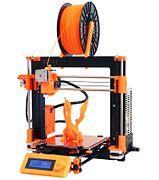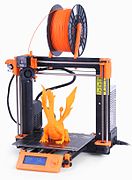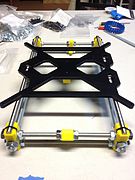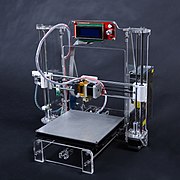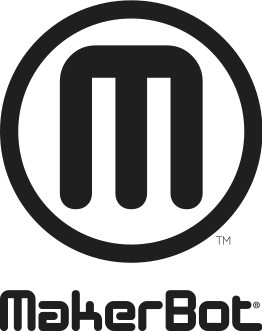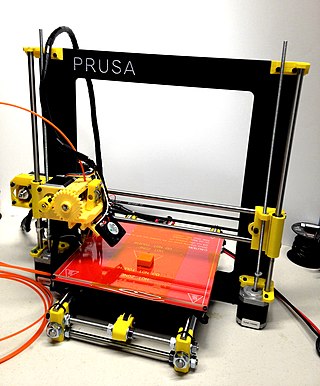Models
- Prusa Mendel
- Prusa Mendel (iteration 2)
- Prusa i3
- Prusa i3 MK2
RepRap Mendel
First conceived in 2009, RepRap Mendel 3D printers were designed to be assembled from 3D printed parts and commonly available off-the-shelf components (referred to as "vitamins," as they cannot be produced by the printer itself). [4] [5] These parts include threaded rods, leadscrews, smooth rods and bearings, screws, nuts, stepper motors, control circuit boards, and a "hot end" to melt and place thermoplastic materials. [6] A Cartesian mechanism permits placement of material anywhere in a cubic volume; this design has continued throughout development of the i3 series. The flat "print bed" (the surface on which parts are printed) is movable in one axis (Y), while two horizontal and two vertical rods permit tool motion in two axes, designated X and Z.
Prusa Mendel
Josef Průša was a core developer of the RepRap project who had previously developed a PCB heated "print bed". He adapted and simplified the RepRap Mendel design, reducing the time to print 3D plastic parts from 20 to 10 hours, and including 3D printed bushings in place of regular bearings. [7] [8] First announced in September 2010, the printer was dubbed Prusa Mendel by Průša himself. [9] According to the RepRap wiki, "Prusa Mendel is the Ford Model T of 3D printers." [10] [11]
Prusa Mendel (Iteration 2)
Průša streamlined his Mendel design, releasing "Prusa Iteration 2" in November 2011. Parts changes allowed for snap-fit assembly (no glue required); fewer tools were needed to construct and maintain this version. Although not required, fine-pitch manufactured pulleys and LM8UU linear bearings were recommended over printed equivalents for "professional" results. [12] [13]
Prusa i3
In May 2012, Průša released a major redesign, focused on ease of construction and use, and no longer structured around the simplest available common hardware as previous RepRap printers were. [14] The Prusa i3 design replaced the threaded-rod, triangular Z axis frame construction with a rigid, single-piece water jet cut aluminium vertical frame. This improved printing speed and accuracy by eliminating the need to erect, align and tighten the upper supports on the Mendel, which were easily skewed or twisted out of alignment from the base. M10 threaded rods were still used to support the heated bed Y axis. It used a single piece, food safe stainless steel hot end called the Prusa Nozzle which printed with 3 mm filament, and used M5 threaded rods as lead screws instead of M8. [15] [16] [17] [18] [19]
In 2015, Průša released an i3 full kit under the brand name "Original Prusa i3". [1] For about three months, the Prusa i3 was delivered set up for a proprietary 3 mm filament diameter (which retrospectively has been dubbed the MK0, or "mark zero"), before the MK1 update when it was switched to the more common filament diameter of 1.75 mm. [20]
Prusa i3 MK2 and MK2S
Průša released the Prusa i3 MK2 in May 2016. It was the first hobby 3D printer with mesh bed leveling and automatic geometry skew correction for all three axes. Features included a larger build volume, custom stepper motors with integrated lead screws, a non-contact inductive sensor for auto-leveling, and a rewritten version of the Marlin firmware. [21] [22] [23] Other new features include a polyetherimide print surface, Rambo controller board and an E3D V6 Full hotend. [24] [25] The Prusa MK2 became the first RepRap printer to be supported by Windows 10 Plug-and-Play USB ID. [26]
In March 2017, Průša announced on his blog that the revised Prusa i3 MK2S would ship in place of the Prusa i3 MK2. [27] Enhancements cited include U-bolts to hold the LM8UU bearings where cable ties had been used, higher quality bearings and rods, an improved mount for the inductance sensor, improved cable management, and a new electronics cover. An upgrade kit was offered to owners of the MK2 to add these improvements.
Prusa i3 MK3 and MK2.5
In September 2017, Prusa i3 MK3 was released, marketed as "bloody smart." [28] Starting with this model, the base and Y axis were assembled with aluminum extrusion, eliminating the last of the structural threaded rods from the Mendel design. Included were a new extruder with dual Bondtech drive-gears, quieter fans with RPM monitoring, faster print speeds, an updated bed leveling sensor, a new electronics board named "Einsy", quieter stepper motors with 128 step microstepping drivers and a magnetic heatbed with interchangeable PEI-coated steel sheets. [29] Electrical components were updated to work with the new 24 volt power supply. The printer also offers dedicated sockets to connect Raspberry Pi Zero W running a fork of the open source OctoPrint software for wireless printing.
Ease-of-use features included a filament detector, allowing the printer to load filament when it is inserted, and to pause printing if the filament is jammed or runs out; error-correcting stepper motor drivers preventing layer shifts due to skipped steps; and recovery after power outages. The ambient temperature sensor both confirms suitable environment temperature and detects overheated electrical connections on the main board.
Existing MK2 and MK2S users were offered a $199 partial upgrade named MK2.5, limited to features which are cheaper to upgrade. [30] After negative feedback from the community, Prusa made available a more expensive $500 MK2S to MK3 full upgrade. [28] [31]
Prusa i3 MK3S and MK3S+
In February 2019, Prusa i3 MK3S was released, along with the Multi Material Upgrade 2S (MMU2S), which allows selecting any of 5 different materials for printing together automatically. [32] MK3S changes include a simplified opto-mechanical filament sensor, improved print cooling, and easier access to service the extruder. [33]
Prusa made a running change starting November, 2020 to the Prusa i3 MK3S+. [34] This model has a revised bed leveling sensor and minor parts changes.
Prusa MK4

In March 2023, Prusa announced the MK4 and the Multi Material Unit version 3 (MMU3). [35] This model features a new i3 version of their "Nextruder" extruder system first seen on the Prusa XL, no-adjustment load cell bed leveling, a modular replaceable all-metal hot end, a color touchscreen, and die-cast [36] aluminum frame, Y-carriage (heat bed support), and extruder frame. [37] The 32-bit main processor board includes additional safety and monitoring circuits, a network connector, a port for the MMU3, and a Wi-fi module. This is Prusa's first Mendel-based design to include support for local and cloud monitoring and support.
Switching to 0.9 degree stepping motors, and the addition of input shaping and pressure advance, allow the Mendel-style design to print faster while avoiding ringing artifacts and other undesirable patterns imposed on the object being made, even though it does not have the advantages of the box-like structure of CoreXY printers. [38] However, Průša has stated that print quality, not maximum speed, is their design goal. There is a provision for an accelerometer, often used in 3D printing for self-tuning of input shaping, but that component is not included in the final design.
When announced, software for input shaping, touch screen operation, and sensor data collection were not finished, and the Multi Material Unit was not ready for release. Upgrade kits for earlier models likewise were not available for shipping.


